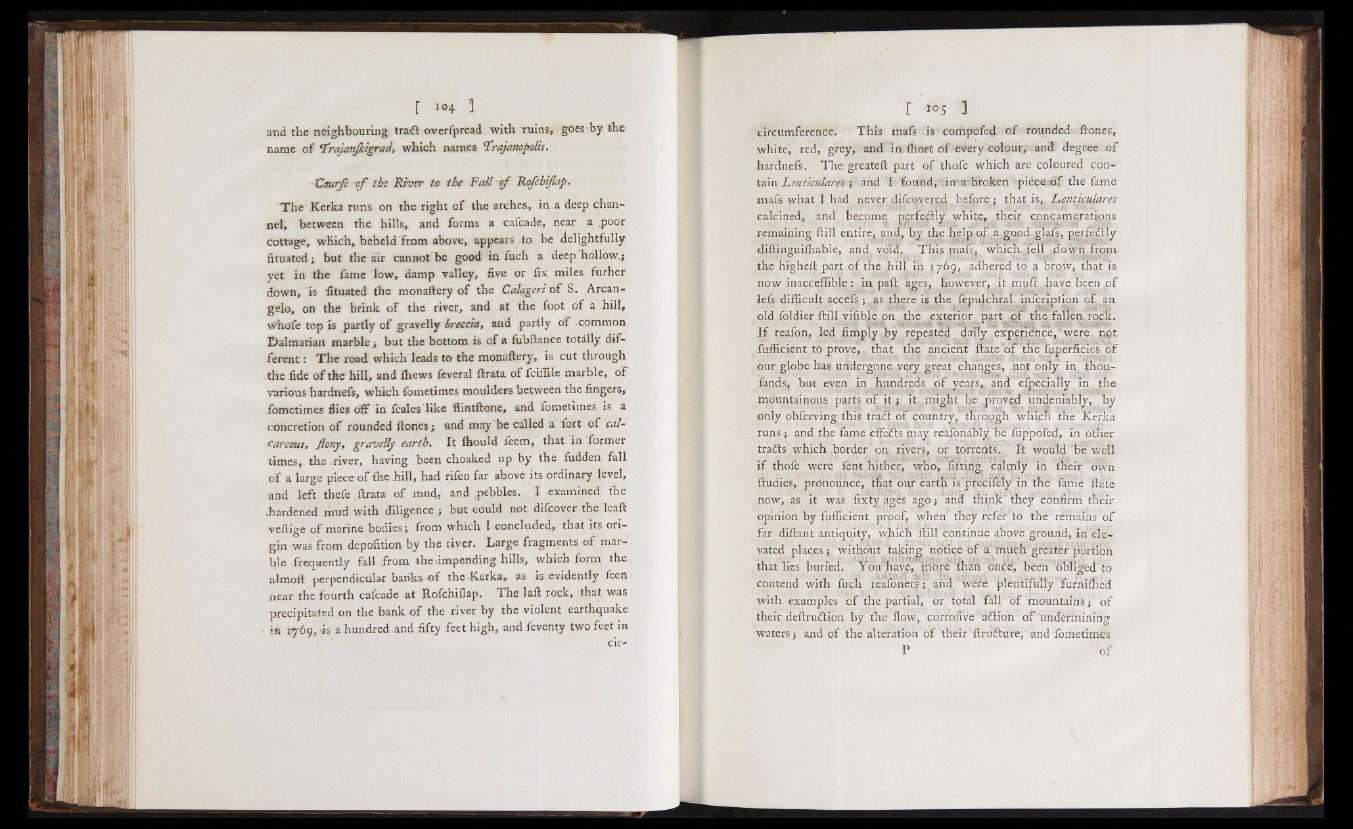
and the neighbouring trait overfpread with ruins, goes «by the
came o f Frajanjkigrad, which names Frajanopol'ts.
Caurfe ~of the River to the F a il o f Rofchijlap.
The Kerka runs on the right o f the arches, in a deep channel,
between the hills, and forms a cafcade, near a .poor
cottage, which, beheld from above, appears to be delightfully
fituated ; but the air cannot be good in fuch a deep hollow.;
yet in the fame low, damp valley, five or fix miles furher
down, is fituated the monaftery o f the Calageri o f S. Arcangelo,
on the brink o f the river, and at the foot o f a hill,
vvhofe top is partly o f gravelly breccia, and partly of common
Dalmatian marble ; but the bottom is o f a fubftance totally different
: The road which leads to the monaftery, is cut through
the fide o f the hill, and fliews feveral ftrata o f fciffile marble, o f
various hardnefs, which fometimes moulders between the fingers,
fometimes flies off in fcales like flintftone, and fometimes is a
concretion o f rounded ftones; and may be called a fort o f calcareous,
Jiony, gravelly earth. It ihould feem, that in former
times, the river, having been choaked up by the fudden fall
o f a large piece o f the F ill, had rifen far above its ordinary level,
and left thefe .ftrata o f mud, and pebbles. I examined the
■hardened mud with diligence.; but could not dilcover thefieaft
veftige o f marine bodies; from which I-concluded, that its origin
was from depofition by the river. Large fragments o f marble
frequently fall from the impending hills, which form the
almoft perpendicular banks-of the -Kerka, as is evidently feen
near the fourth cafcade at Rofchiflap. The laft rock, that was
precipitated on the bank o f the river by the -violent earthquake
in 1769, -is a hundred and fifty feet high, and feventy two feet in
circumference. This mafs is cotftpofed o f rounded ftones,
white, red, grey, and in ihort o f every colour, and degree o f
hardnefs. The greateft part o f thofe which are coloured contain
Lenticulares ; and I found, ima broken p ie ce o f the fame
mafs what I had never difcqverp^ before ; that is,. Lenticulares
calcined, and become pprfeftly whitp, their concameratpops
remaining ftill entire, and, b y the help o f a good glafs, nerfefljy
diftinguifhable, and void. This mais, which.fell down from
the higheft part o f the hill in 1769, adhered to a brow, that is
now inacceifible.: in paft ages, however, i t rnpfi, have been o f
lefs difficult accefs ; as there is the fepulchral infcription o f an
old foldier ftill vifible on thé exterior pprt -of the fallen rock.
I f reafon, led limply by repeated daily expèrience, werè pet
fufficient to prove, . that the ancient ftate o f the fpperficies o f
our globe has undergone yçry great changes, hot only in. thou-
fands, hut even in hundreds, o f years,, apd efpecially in the
mountainous parts o f it ; it might be .prôvçd undénîàbly, by
only obferving this trade o f country, through wnicn the Kerka
runs ; and the fame effeits may realoriably fie Tuppofed, in other
trails which border on rivers, or torrents. It would fié well
i f thofe were fent hither, who,’ fitting'' calmly in their own
ftudies, prdnounce, that opr eartlïis'précifèly in the* famé ftâté
now., as it was fixty ages ago ; 'and' think they cônfirm their
opinion by fufficient proof, when they refer to the remains o f
far diftant antiquity, which ftill'continuè above ground, in elevated
places; withoht taking notice of'a'hfjuch greater portion
that lies buried. You have, mope than Once, bee'n ofifig'ed fo
contend with fucn reaioner? ;, and Yveré plentifully furnifÎied
with examples o f the partial, or total fall o f mountains ; o f
their deftruétion by the flow, corrofive “action o f undérininirig
waters; and o f the alteration o f their ftrufture, and fometimés
P o f